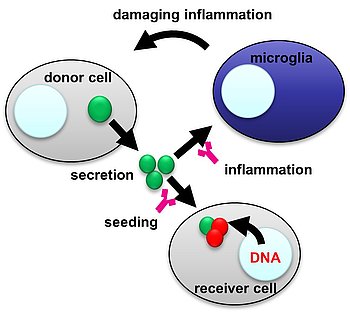Treating C9orf72 ALS/FTD with active vaccination
Challenge
Expansion of a (G4C2) hexanucleotide repeat upstream of the C9orf72 coding region is the most common genetic cause of amyotrophic lateral sclerosis (ALS) and frontotemporal dementia (FTD). C9orf72 cases show nuclear foci of sense and antisense repeat RNA transcripts and unique aggregates of dipeptide repeat (DPR) proteins resulting in abundant poly-GA inclusion pathology throughout the CNS in patients. Transgenic mice expressing (GA)149 conjugated with cyan fluorescent protein (CFP) progressively develop poly-GA inclusions predominantly in motoneurons and interneurons of the spinal cord and brain stem and in deep cerebellar nuclei triggering motor deficits and neuroinflammation. Neuropathological reports from presymptomatic C9orf72 cases suggest that all pathognomonic features of the disease are present decades before onset of symptoms. A disease-modifying therapy or prevention for this or other forms of ALS/FTD doesn’t exist. Thus, targeting the C9orf72-specific pathomechanisms early will be essential for effective disease prevention or therapy.
Technology
The rational for the technology was that removing DPR proteins and especially poly-GA as the most abundant DPR species could be beneficially in C9orf72 ALS/FTD. Since poly-GA is transmitted between cells, the therapeutic potential of anti-GA antibodies by vaccinating (GA)149-CFP mice has been investigated. Immunizing wild-type (WT) and (GA)149-CFP transgenic expressing mice (TG) with OVA/KLH-PEG-(GA)10 elicited a strong immune response (high titer anti-GA antibodies) without side effects and reduced motor deficits in TG mice. It could be shown that a high antibody titer is necessary for the beneficial effect of vaccination. Histologically, vaccination clearly reduced poly-GA aggregation in the spinal cord and prevented microglia activation nearly completely. In addition, poly-GA immunization reduced DNA/RNA binding protein TDP-43 mislocalization by reducing levels of cytoplasmic TDP-43 and prevented neuronal damage.
Commercial Opportunity
This is the first time that an active anti-GA immunization was shown to have a therapeutic effect in an animal model of C9orf72 ALS/FTD. Therefore, active vaccination is a promising approach to reduce disease severity or even prevent ALS and FTD in people carrying the C9orf72 mutation. Early treatment of C9orf72 mutation carriers with a safe and effective poly-GA vaccine may prevent transition from the prodromal DPR-dominated disease stage to the symptomatic disease associated with TDP-43 pathology.
The technology is open for licensing, further preclinical and clinical co-development is highly welcomed.
Development Status
For the first time it could be shown that an active anti-GA vaccination approach resulted in a surprisingly high antibody titer in the plasma and significant titers in the CSF. Furthermore, beneficial effects on neurofilament light chain (NFL) levels could be demonstrated, which is the best currently available fluid biomarkers for neurodegeneration. In addition to reducing poly-GA levels and neuroinflammation, the immunization strategy also has positive effects on downstream TDP-43 pathology.
Patent Situation
A PCT patent application has been filed in 2020 (priority May 2019).
Further Reading
Zhou et al. (2020), EMBO Mol. Med. 12:e10919





